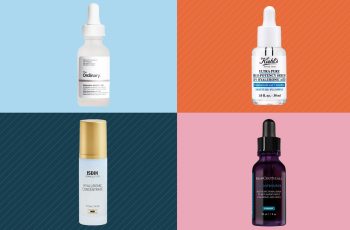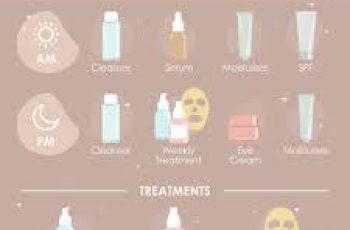The Science of Iron Oxide in Skin Care
Chances are, you’ve used a skin care or cosmetic product that contains iron oxide – but you may have not known it. Iron oxides are commonly found in tinted sunscreens and makeup products as a natural colorant. They also come along with a few key benefits to the skin, including the ability to block blue light from penetrating your skin and to help keep melasma and other forms of hyperpigmentation at bay.
Before we can help you decide if iron oxide-containing products could be right for your skin, make sure you know which of the 16 Baumann Skin Types you are first. Then, use the information in this guide as a starting point to decide if and how to incorporate them into your skin care regimen.
Iron oxides provide tint to many sunscreens and makeup products.
They also help to block blue light from penetrating your skin.
This blue light-blocking ability makes iron oxides helpful at preventing melasma.
What Is Iron Oxide?
Iron oxides, also called ferric oxides, are naturally occurring minerals found in various natural colors, though red is the most common hue used in cosmetics. In skin care and cosmetics, iron oxides are used as pigments to give products a natural tint without synthetic dyes. They are also UV-stable and resistant to oxidation, so they maintain their color in sunlight and don’t easily degrade.
The iron oxides used in cosmetic products are processed to remove impurities, making them safe for cosmetic use. There are three main types of iron oxide pigments commonly used in skin care:
CI 77491 (red)
CI 77492 (yellow
CI 77499 (black)
Skin Benefits
While they are most commonly used as a tint for sunscreens and makeup, iron oxides also have a few other key benefits for your skin:
Blocks blue light. Blue light has very short, high-energy waves, so it is able to penetrate deeper into the skin than UVB and UVA rays. Here, blue light can stimulate melanocytes (the cells that produce melanin), which trigger melanin production. This can cause dark spots and other forms of hyperpigmentation like melasma. Iron oxides form a physical barrier over the skip and are able to reflect and scatter blue light, thus reducing its effects on melanocytes and preventing excessive pigmentation.
Helps to prevent melasma. This ability to shield skin from blue light helps to reduce hyperpigmentation, including melasma. Melasma is often worsened by blue light, which is why dermatologists like Dr. Baumann often recommend tinted sunscreens that contain iron oxides to help prevent melasma from recurring.
Antioxidant protection. Studies have found that certain iron oxide nanoparticles have the potential to provide antioxidant protection by reducing oxidative stress, a process in which free radicals damage skin cells and accelerate aging (3).
Side Effects
Iron oxide is considered safe for cosmetic use and has a low hazard rating on the Environmental Working Group (EWG) Skin Deep database. Unlike some chemical sunscreen ingredients and colorants, iron oxides are non-irritating and are generally safe for sensitive skin types. Iron oxides are also non-comedogenic, so they’re unlikely to clog pores.
However, as with any ingredient, there is a small chance of an allergic reaction to certain iron oxides, although this is rare.
Sunscreens with Iron Oxide
Mineral sunscreens, also called physical sunscreens, are a great chemical-free alternative to traditional chemical sunscreens. Mineral sunscreens contain ingredients like zinc oxide and/or titanium dioxide to reflect UV rays away from your skin. However, one of the challenges with these sunscreens is that they tend to create a white hue on the skin. Iron oxides can be added to mineral sunscreens to provide a natural tint that helps to blend the sunscreen with your skin tone for a clearer, smoother finish.
As an added bonus, tinted sunscreens with iron oxide offer both UV and blue light protection, making them ideal for people with melasma or those who spend a lot of time in front of a computer screen.
Some of the best mineral sunscreens that contain iron oxide include:
Iron Oxide in Makeup
Iron oxide is also widely used in makeup products like foundations, BB creams, and concealers to provide natural tints. While these products can provide some sun protection, don’t rely on these products alone for full UV protection. This is because you would have to apply much more makeup than most people are comfortable with applying in order to reach the necessary SPF to keep your skin protected.
To keep your skin protected from both sun damage and blue light, you can layer makeup with an SPF sunscreen underneath, or use a tinted sunscreen as a base.
Bottom Line
Iron oxide is a common ingredient used in many sunscreens and makeups to provide a natural tint. In addition to its use as a natural pigment, iron oxide also provides benefits such as blocking blue light and helping to prevent melasma and other forms of hyperpigmentation. Choosing a sunscreen that contains iron oxides can protect your skin against both UV light and blue light. Just be sure you are choosing a sunscreen that is right for your skin type so that you will wear it every day!
DQH Knowledge drop: In your 20s, your skin cell turnover decreases. (Cell turnover is a key component in keeping your skin youthful.) You know what else slows down? Your collagen production. Starting in your 20s, collagen decreases by about 1 percent per year. Should you want to prevent fine lines and wrinkles, start by eliminating behaviors that contribute to premature aging. “If it’s bad for you, it’s bad for your skin,” says dermatologist Michel Somenek.
“Cigarette smoking reduces blood flow to the skin and causes premature wrinkling and a dull skin texture. Making the repeated pursed motion to inhale can also cause smoker’s lines. Alcohol and recreational drugs are toxins for the skin that damage its cellular structure and DNA,” Somenek tells us. “The faster you eliminate vices while you are young, the better chance your skin and body have to recuperate.” Also, adopting an anti-aging routine in your 20s is key. After all, the best offense is a good defense. We spoke to Somenek and experts Joshua Ross and Audrey Kunin to find out more.
Keep reading for the best anti-aging products for your 20s, according to skincare professionals.
Sunscreen
“We all know that the sun is the number one cause of skin aging and starting the prevention in your 20s is very important,” Ross says. “The majority of your sun damage won’t start to appear until you’re in your 30s, so don’t wait until you see it surface or you’ll be behind the curve. Stay ahead of it with a good-quality zinc-based sunscreen worn daily.”
Farmacy Green Defense Daily Mineral Sunscreen
An invisible sunscreen with SPF 30, plus botanical extracts meant to protect skin with tons of antioxidants. Bonus: It’s clean and fine to use under makeup.
Bareminerals Complexion Rescue™ Tinted Moisturizer Broad Spectrum SPF 30
Although we recommend you use your SPF and moisturizer separately, we also understand moments when you don’t have time or energy for that extra step. For those times, this bareMinerals moisturizer is a great thing to have on hand.
Vitamin C Serum
“A great introduction to anti-aging is to start with a vitamin C serum in your morning skincare routine,” Ross says. “It’s a powerful antioxidant that will neutralize free radicals and brighten the skin.” He adds that it’s a great way to counteract the effects of the sun’s harmful rays, which, as previously mentioned, are among the biggest causes of premature aging.
Drunk Elephant C-Firma™ Vitamin C Day Serum
The Drunk Elephant C-Firma is a lightweight serum that promises to give skin a glow by combining the brightening powers of vitamin C with ferulic acid, l-ascorbic acid, and vitamin E. The included sodium hyaluronate is meant to replace hydration loss, so you shouldn’t have to deal with any irritation.
Sunday Riley C.E.O. Rapid Flash Brightening Serum
This potent serum is jam-packed with vitamin C (15 percent, to be exact), which means it’s a potential superstar at both brightening skin and dousing it in antioxidants.
Peptides
Using peptides on your skin has many benefits, says Somenek. “The skin barrier is what defends the body against pollution, UV rays, bacteria, and toxins. It can be damaged by several everyday factors. Using topical peptides aids in building a stronger barrier,” he says. “Peptides comprise elastic fibers, which are a type of protein. These fibers help to make skin appear taut and firm. Peptides can also help repair damaged skin, relieve inflammation, and even out skin tone. Some peptides can kill acne-causing bacteria that is common in 20-somethings.”
Kunin agrees, saying, “Peptides are an excellent entry point for supporting collagen.” She recommends looking for face and eye treatments that contain these collagen-boosting powerhouses.
Charlotte Tilbury Magic Eye Rescue Cream
This Charlotte Tilbury super-emollient eye cream has a base of coconut oil and shea butter (read: it’s incredibly hydrating). Botanicals plus peptides are meant to help reduce dark circles and boost collagen, respectively.
This creamy moisturizer serves up potent collagen-boosting peptides and pycnogenol, and antioxidant-rich vitamin C. “Instead of sitting on top of the skin, peptides penetrate the outer layer so they go deep. The ‘signals’ they send tell the cells to produce elastin and collagen, which are needed for youthful-looking skin,” explains Somenek.
At-Home Peel Pads
Remember that skin cell turnover fiasco we talked about earlier? One way to help support it is by exfoliating. “Exfoliation is important to help keep skin fresh and luminous,” Kunin says. She recommends using at-home peel pads as an easy and effective way to exfoliate.
“The goal in your 20s is to fight the slowing pace of cell turnover. It is wise to use products that gently exfoliate, yet still remove oil and other impurities. Products that have Alpha Hydroxy Acids (AHA) or Beta Hydroxy Acids (BHA) are a good choice.”
According to Somenek, you should only exfoliate two to three times a week. “People of all ages are guilty of over-exfoliating and that can be too much of a good thing,” he says.
Dermadoctor Kakadu C Intensive Vitamin C Peel Pad
A few swipes of this Derma Doctor powerful peel pad promise to leave your skin glowing and smooth, thanks to the seven (yes, seven) types of chemical exfoliants, including AHA and BHA. It also contains vitamin C via Kakadu plum extract for added brightening and antioxidant protection.
KEY INGREDIENTS Kakadu plum extract is sourced from the Kakadu plum, a fruit grown in northern Australia. It contains vitamin C, which restores the skin’s natural barrier, increases collagen production, and soothes irritation.
Dr. Dennis Gross Skincare Alpha Beta® Universal Daily Peel Pads
These are the gold standard of peel pads, with a cult following and over 900 five-star reviews on Sephora. They’re easy to use and contain a blend of anti-aging exfoliating acids.
Emollient Night Cream
“In your 20s, you need to start upping the hydration in your skincare routine. You may have been cautious of over-moisturizing because of acne in your teens, but as you enter your 20s, your skin transitions and becomes drier,” Ross says. “I recommend an emollient night cream added into your evening skincare regimen.”
“Twenty-somethings need to make sure that they are not using creams that will clog their pores and cause excess oil production,” says Somenek. Opt for non-comedogenic products.
Cerave Skin Renewing Night Cream
One great choice is the CeraVe Skin Renewing Night Cream, which is a non-comedogenic night cream that leaves skin soft and glowy. It combines the moisturizing powers of ceramides and hyaluronic acid.
RoC Retinol Correxion Max Hydration Creme
“The best night cream ingredients contain retinol, benzoyl peroxide, and/or salicylic acid or hyaluronic acid. The goal is to moisturize, yet remove excess oil,” says Somenek. This Roc Retinol Correxion cream fits the bill as it contains both hyaluronic acid and retinol so it promises to moisturize while also being non-comedogenic.



